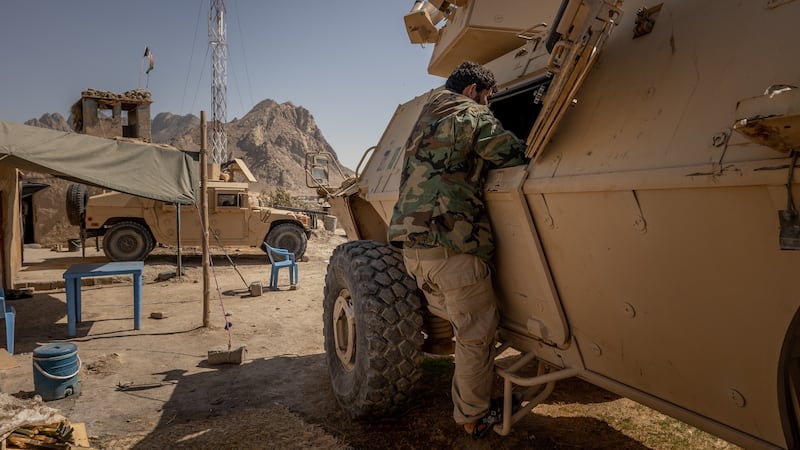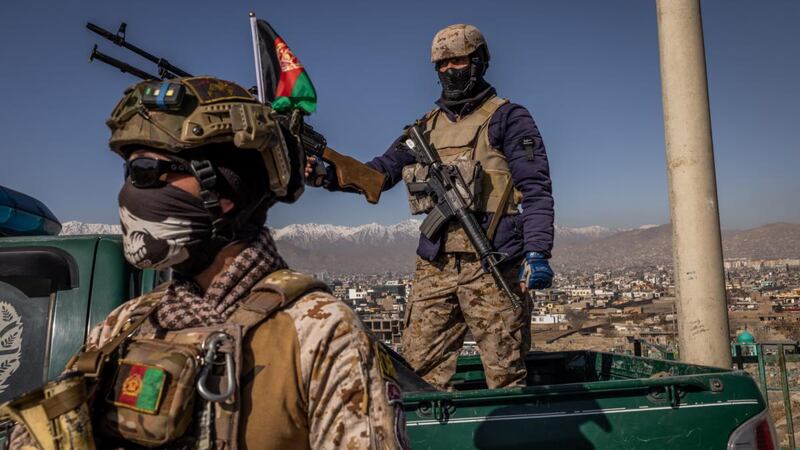The Pentagon is considering seeking authorisation to carry out air strikes to support Afghan security forces if Kabul or another major city is in danger of falling to the Taliban, potentially introducing flexibility into President Joe Biden's plan to end the US military presence in the conflict, senior officials said.
Biden and his top national security aides had previously suggested that once US troops left Afghanistan, air support would end as well, with the exception of strikes aimed at terrorist groups that could harm US interests.
But military officials are actively discussing how they might respond if the rapid withdrawal produces consequences with substantial national security implications. No decisions have been made yet, officials said.
But they added that one option under consideration would be to recommend that US warplanes or armed drones intervene in an extraordinary crisis, such as the potential fall of Kabul, the Afghan capital, or a siege that puts US and allied embassies and citizens at risk.

Any additional air strikes would require the president's approval. Even then, officials indicated that such air support would be hard to sustain over a lengthy period because of the enormous logistical effort that would be necessary given the US withdrawal. The United States will leave all its air bases in Afghanistan by next month, and any air strikes would most likely have to be launched from bases in the Persian Gulf.
A potential fall of Kabul is the crisis most likely to lead to military intervention after US troops leave, officials said. Intervening to protect Kandahar, Afghanistan's second-largest city, would be far less certain, one official said. Encroaching Taliban forces have increasingly threatened several other urban hubs in almost every corner of the country in recent months.
The discussion suggests the degree of concern in Washington about the ability of Afghanistan’s military to hold off the Taliban and maintain control of Kabul and other population centres. And it is the latest indication of the scramble by the United States to address the ramifications of Biden’s decision in April to order a full withdrawal – a goal that had eluded his two immediate predecessors, in part because of opposition from the military.
Nato meeting
Whether to provide air support to Afghan security forces after US troops pull out is one of several major questions about Afghanistan policy that the administration is grappling with as Biden prepares to meet Nato allies in Europe next week.
Also unresolved is how US troops will carry out counterterrorism missions to prevent al-Qaeda and other militants from rebuilding their presence in Afghanistan, and how to allow western contractors to continue to support the Afghan military. At the same time, the CIA is under intense pressure to find new ways to gather intelligence and carry out counterterrorism strikes in the country.
With the Pentagon set to conclude the pullout of US troops by early July, the Afghan military – created, trained and supplied in the image of the US military – is supposed to start defending the country on its own. Senior American officials say that the immediate crumbling of the Afghan military is not a foregone conclusion. But there is little doubt that the Afghan forces are battered and at risk of being overwhelmed, especially if their commandos and air forces falter.

The United States is not likely to provide additional air support to Afghan forces in rural areas, many of which are already under Taliban control, the officials said. And even government enclaves around the country, which are already under siege, are unlikely to receive much military help from US warplanes, the officials said.
They spoke on the condition of anonymity to avoid speaking publicly about internal administration discussions.
When Biden announced the withdrawal in April, he promised to support the Afghan government, including its security forces, but he appeared to indicate that the Afghans would be on their own militarily after US and Nato troops left this summer. “While we will not stay involved in Afghanistan militarily, our diplomatic and humanitarian work will continue,” he said at the time.
Officials said then that the United States would launch strikes in Afghanistan only for counterterrorism reasons, in case there was intelligence about efforts to attack US interests.
A spokesperson for the White House’s National Security Council declined to comment on the options under discussion, saying the administration did not publicly discuss rules of engagement. But officials say there appears to be some new flexibility in the interpretation of counterterrorism. They say a debate has risen in the administration over what, exactly, is the threshold for turmoil in Afghanistan that could lead to US air strikes.
Isis lessons
The discussion reflects lessons learned from the rise of the Islamic State group in Iraq, which forced the Obama administration in 2014 to recommit troops and air cover to defend Iraqi cities as the group encroached on Baghdad.
Senior officials said that at the moment, that threshold looked like a looming fall of Kabul, a situation that would most likely require a sign-off from the president before US warplanes – most likely armed MQ-9 Reaper drones but possibly fighter jets – provided air support to Afghan forces.
Afghan officials said they had been told by their American counterparts that the United States would also stop any takeover of major cities, a vague statement without any clear backing. That support would be tough to maintain over any extended period.
"It's a very hard thing to do," said Gen Joseph Votel, the former commander of US Central Command. "It's an operation to get aircraft to Afghanistan, especially if you're having to come from the Gulf or an aircraft carrier. There is limited loiter time for them to do anything."
There are already signs of the difficulties that the United States would face in sending crewed aircraft to carry out strikes after the withdrawal. As US bases in Afghanistan close, it has left pilots with a conundrum: What if something goes wrong thousands of feet over Afghanistan?
Forward Operating Base Dwyer – a sprawling complex in the south with a sizable landing strip – is closing in weeks, if not days. At that point, US aircraft will have only one viable US military base, Bagram, to divert to if they face a mechanical or other issue in flight. Bagram will shut down when the withdrawal is complete.
With restrictive rules of engagement that require hours of overhead surveillance before a US air strike is authorised, Afghan forces have tried to compensate, launching 10 to 20 air strikes a day. US surveillance drones are providing a wealth of co-ordinates to the Afghan Air Force, but Afghan pilots and aircraft are facing burnout and maintenance issues that grow by the day as foreign contractors withdraw.
"Our policy should be to do everything possible, consistent with not having troops on the ground, to enable the legitimate Afghan government and security forces to hold on," said Representaive Tom Malinowski, a Democrat and a former state department official.
Malinowski last month joined more than a half-dozen other House Democrats and Republicans in urging Biden to provide an array of support to the Afghan government after US troops leave, including any information on impending Taliban attacks detected by US surveillance aircraft and spy satellites.
Fear of collapse
Top US generals have acknowledged that the Afghan security forces could collapse in a year or two, or even a matter of months, after the departure of western military support.
Gen Mark Milley, chair of the joint chiefs of staff, offered reporters travelling with him last month a lukewarm statement about the abilities of the Afghan forces. After 20 years of war, thousands of casualties and huge sums of money spent on the Afghan military and police, he characterised them as "reasonably well equipped, reasonably well trained, reasonably well led".
When pressed on whether he thought the Afghan forces could hold up, Milley was noncommittal. “Your question: The Afghan army, do they stay together and remain a cohesive fighting force, or do they fall apart? I think there’s a range of scenarios here, a range of outcomes, a range of possibilities,” he said.
“On the one hand, you get some really dramatic, bad possible outcomes. On the other hand, you get a military that stays together and a government that stays together.
“Which one of these options obtains and becomes reality at the end of the day?” he said. “We frankly don’t know yet.” – New York Times










